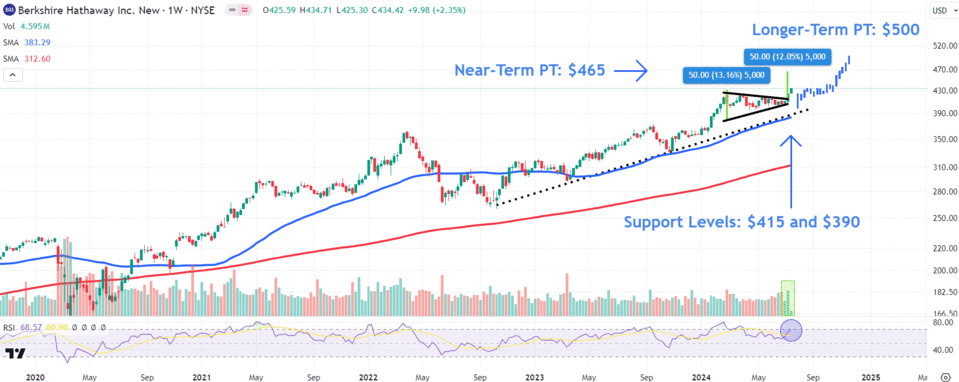
Key Takeaways
-
Shares in Berkshire Hathaway closed at a record high on Monday, buoyed by gains in some of the conglomerate’s key holdings.
-
The stock broke out from a symmetrical triangle, a chart pattern that suggests a continuation of the current uptrend.
-
The measuring principle projects a near-term price target in the shares of $465, while a bars pattern projects a longer-term target of around $500.
-
During retracements, Berkshire shares may find support around $415 from the symmetrical triangle’s top trendline, and near a multi-month uptrend line at $390.
Shares in Warren Buffett’s Berkshire Hathaway (BRK.A, BRK.B) closed at a record high on Monday, buoyed by gains in some of the conglomerate’s key holdings, including Apple (AAPL), American Express, (AXP), Chevron (CVX), and Occidental Petroleum (OXY). Investors typically view the performance of the company’s stock, which trades at about 23 times analysts’ full-year operating profit projections, as a proxy for the health of the U.S. economy due to its diversification across a broad range of industries.
Berkshire Hathaway shares added 2.4% to finish Monday’s session at $434.42.
Amid the stock’s move to record highs, we’ll take a closer look at the technicals on the Berkshire Hathaway weekly chart and identify important levels to watch out for.
Breakout From Symmetrical Triangle
Since bottoming out midway between the 50- and 200-week moving averages (MAs) in early October last year. Berkshire shares have trended consistently higher. More recently, the price broke out from textbook symmetrical triangle, a chart pattern that indicates a continuation of the current uptrend.
Importantly, the initial breakout from the pattern occurred on the highest weekly trading volume since late February, suggesting buying conviction behind the move. Moreover, the relative strength index (RSI) sits just below overbought levels to confirm strong price momentum in the stock.
Monitor These Price Levels Amid Further Upside
Below, we’ll use two different technical analysis techniques to predict near-term and longer-term price targets. These levels help us determine a general area on the chart where Berkshire shares may climb to and encounter resistance if the price continues to trend higher.
Near-Term Price Target
To forecast a potential short-term price target, we can use the measuring principle. We do this by calculating the distance between the symmetrical triangle’s two trendlines near their widest point and apply that amount to the breakout area. For example, we add $50 to $415, which projects a target at $465
Longer-Term Price Target
Investors can speculate a longer-term price target by using a chart overlay of prior price action. This works by taking the bars pattern from the uptrend that preceded the symmetrical triangle and applying it to the most recent swing low. In this case, we take the bullish bars pattern between October 2023 and February this year and align it with the April low, which indicates a possible upside target of around $500.
Watch These Key Retracement Areas
Investors looking for a key pullback level should keep an eye on the $415 area, where Berkshire shares would likely find buying interest near the symmetrical triangle’s top trendline. A more significant retracement could see the stock revisit a multi-month uptrend trendline around $390, with this location also sitting in close proximity to the 50-week MA.
The comments, opinions, and analyses expressed on Investopedia are for informational purposes only. Read our warranty and liability disclaimer for more info.
As of the date this article was written, the author does not own any of the above securities.
Read the original article on Investopedia.
